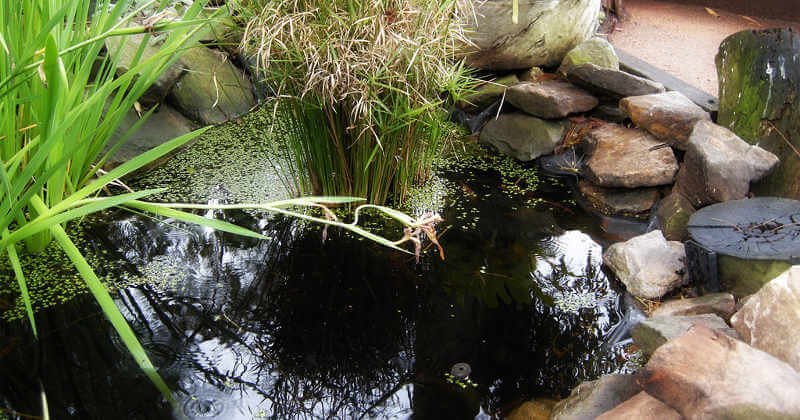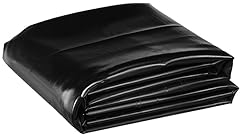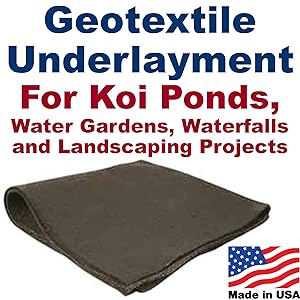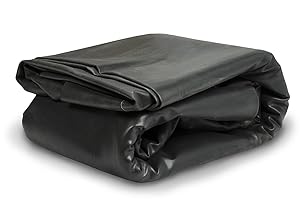The reason we build and install a koi pond or water garden is to place a piece of nature where we want it. Chances are a pond will never develop in your backyard next to your deck.

(source)
The fact is, if you want that koi pond or water garden you’ll have to build it yourself. That’s really good news because most natural ponds are not suited to hold koi, goldfish and flowering water lilies. They’re either too deep, too shallow, too wide or too small to keep our fish and plants alive and healthy.
That’s why we build our own backyard ponds and water gardens. When we design it ourselves, we get to choose everything from where it will be positioned in our yard to how deep and wide.
Sure, you could buy a pre-formed plastic pond liner but those certainly limit your creativity and choices. Pre-formed ponds only come in small sizes and shallow depths. You’ll have to dig the hole in the exact shape and depth of the plastic shell or else the pond shell will buckle from lack of support. Pre-formed pond liners often have raised plant shelves molded into the shape of the pond.
Unfortunately, the shelves are often not wide enough to support large potted aquatic plants. With a pond liner, you can even design a beautiful stream that flows into the pond.
There is no limit to what kind of pond or water feature you can create! When you use a flexible pond liner, you get to decide where you want the raised shelves, how many and where. Flexible liners conform to the shape of the hole in the ground. You can dig any shape pond you want.
Common shapes include:
- Round
- Egg-shaped
- Kidney bean shape
- Oval
- Square
- Rectangle
- Freeform
What to look for in a pond liner?
There are many kinds of flexible “plastic” materials but not all are suitable for lining your pond. Most plastics if used as a pond liner will degrade in a few years due to the constant exposure to sunlight, ozone, water and fluctuating temperature.
A pond liner must be resistant to UV radiation so it does not become brittle, crack and leak. The liner should also have the ability to stretch in response to temperature changes, shifting weight when you drain some water and move plants around.
Pond liner thickness is measured in “mils.” One mil equals one thousandth (0.001) of an inch.
Let’s take a look at the four most common materials used to make pond liners.
PVC
PVC (Polyvinyl Chloride) has been used for decades in aboveground swimming pools. a low-cost plastic and is used in budget pond kits. Vinyl liners are thinner (20 mils).
This makes vinyl liners lighter and easier to work with when lining the pond. The downside is a shorter lifespan compared to other types of liner materials.
If the liner doesn’t have UV inhibitors, it will quickly become brittle and crack.
PVC has low puncture resistance. Abrasion and pressure caused by roots, rocks, animals, pets and working in the pond can lead to leaks.
LDPE
LDPE (Low Density Polyethylene) is a common type of flexible plastic sheeting used as tarps, agriculture, construction sites and more.
It is very flexible and conforms well to the inside of a pond. It can have thickness up to about 40 mils. LDPE is not as strong or puncture resistant as other liner materials.
EPDM
EPDM (Ethylene propylene diene monomer) is a synthetic rubber. There are many types of EPDM products ranging from roofing material to door seals in automobiles. EPDM manufactured specifically for ponds is completely safe for use with fish and plants.
EPDM is very tear and puncture resistant. It remains stretchy and flexible. You’ll be able to stand inside your pond without fear of damaging the liner. The rubber is ultraviolet stabilized and will resist drying out and becoming brittle.
EPDM costs more than other liner materials but the strength and durability offset the added cost. EPDM liner material is normally 45 mils thick.
The material is very heavy compared to other materials. It is more difficult to install and fold to the shape of the pond. EPDM lines can even have 20-year or longer warranties.
Don’t forget the underlayment
No matter which material you choose, be sure to use underlayment.
The first step in successful liner installation is using a good underlayment to provide a physical, protective barrier between the ground and the pond liner. Do-it-yourself pond books and websites suggest using sand, layers of newspaper, old carpet.
The best and most reliable underlayment material is a non-woven geo-textile fabric. Non-woven underlayment is an extremely tough, non-degradable material. It limits root penetration and damage from rocks. Inside the pond, it adds an extra protection when working inside the pond, visiting pets and wildlife.
Pond liner calculation
There are two ways of figuring out how much liner you’ll need.
- Dig the pond and then take measurements,
- Design the pond on paper first.
Calculating the liner’s size is easy. All you will need to do is measure the pond’s width, length and depth and then do some simple math. These calculations work in feet, yards or meters.
- Length + Depth + Depth +2 = Length of Liner
- Width + Depth + Depth + 2 = Width of Liner
These two calculations will give you the square feet/yards/meters needed to line the pond and provide enough overlap for the sides.
Top rated pond liners list
1. TotalPond EPDM Pond Liner
TotalPond is manufacturer of economical, high quality pond accessories and pumps. The liner comes in a variety of sizes (approximate):
- 10’ x 15’: (6 x 9 x 1.5-foot pond),
- 15’ x 15’: (9 x 9 x 1.5-foot pond),
- 15’ x 20’ (9 x 12 x 1.5-foot pond),
- 20’ x 20’ (12 x 10 3-foot pond).
TotalPond EPDM lines are 45-mil think for extra strength and durability. Its UV and weather resistant allowing it to withstand challenging environments. This liner is made in China and has a 20-year warranty.
 More at Amazon More at Bradshaws UK
More at Amazon More at Bradshaws UK
2. Beckett Pond PVC Liner
Becket has been manufacturing pond liners, pumps and filters for over 15 years.
This PVC liner has a 20- mil thickness.
The low weight and economical cost make this an attractive option for new water gardeners starting out with a smaller pond.
The UV-resistant PVC has a 15-year warranty.
The 12’ x 17’ liner will make a maximum size pond of approximately 945 gallons.
 More at Amazon More at Bradshaws UK
More at Amazon More at Bradshaws UK
3. Firestone EPDM Pond Liner
Firestone liners are considered top-of-the line. These EPDM liners have 45 mil thickness.
Their life expectancy is about 75 years. EPDM has a high flexibility even in cold weather.
Although heavier than PVC, it can be shaped to fit the contours of any pond.
Firestone liners have outstanding resistance to UV radiation, ozone and other environmental conditions.
EPDM has a high tensile strength and resists punctures. This liner has a 20-year warranty.
 More at Amazon More at Bradshaws UK
More at Amazon More at Bradshaws UK
4. Aquascape EPDM 45 Mil Rubber Liner
Aquascape Designs is a supplier of pond supplies including water pumps, fountains, treatments and pond liners.
They offer EPDM liners in a variety of pre-cut sizes from 8’ x 10’ to 20’ x 25’.
The rubber is 45-mil thick and highly resistant to punctures.
The liner can also be used to line streams and waterfalls. The material is easy to cut and seal if you want to add a skimmer box or bottom drain.
Aquascape Designs offers a 20-year warranty on their EPDM liners.
5. Geotextile Underlayment
Don’t forget to protect your liner with underlayment. This professional geotextile is easy to use and install.
Just roll it out and cut to fit. Nonwoven geotextile fabrics are made for stabilizing soil, preventing rocks and roots from penetrating pond liner and for creating ’rock pads’ to cushion large rocks and boulders placed in the pond on top of the liner.
Just lay the pieces next to each other and install the pond liner. Use any leftover underlayment to create pads for large rocks and boulders placed inside your pond.
 More at Amazon More at Bradshaws UK
More at Amazon More at Bradshaws UK
Final recommendations
Any of these pond liners are suitable for creating a beautiful pond or water garden. As discussed, PVC is lightweight and easy to handle but has a shorter lifespan.
EPDM is the choice of professionals, especially for larger ponds.
If you’re creating a small water garden or pond (200-400 gallons) and have a tight budget, an economical PVC liner will get you started in the hobby.
For larger ponds, especially in locations with rock and root puncture potential, EPDM is the way to go. The extra weight and expense will be outweighed by the longer warranty and peace of mind knowing you’ve used the best pond liner available.
NavigationWhat to look for in a pond liner?PVCLDPEEPDMDon’t forget the underlaymentPond liner calculationTop rated pond liners list1. TotalPond EPDM Pond Liner2. Beckett Pond PVC Liner3. Firestone EPDM Pond Liner4. Aquascape EPDM 45 Mil Rubber Liner5. Geotextile UnderlaymentFinal recommendations


